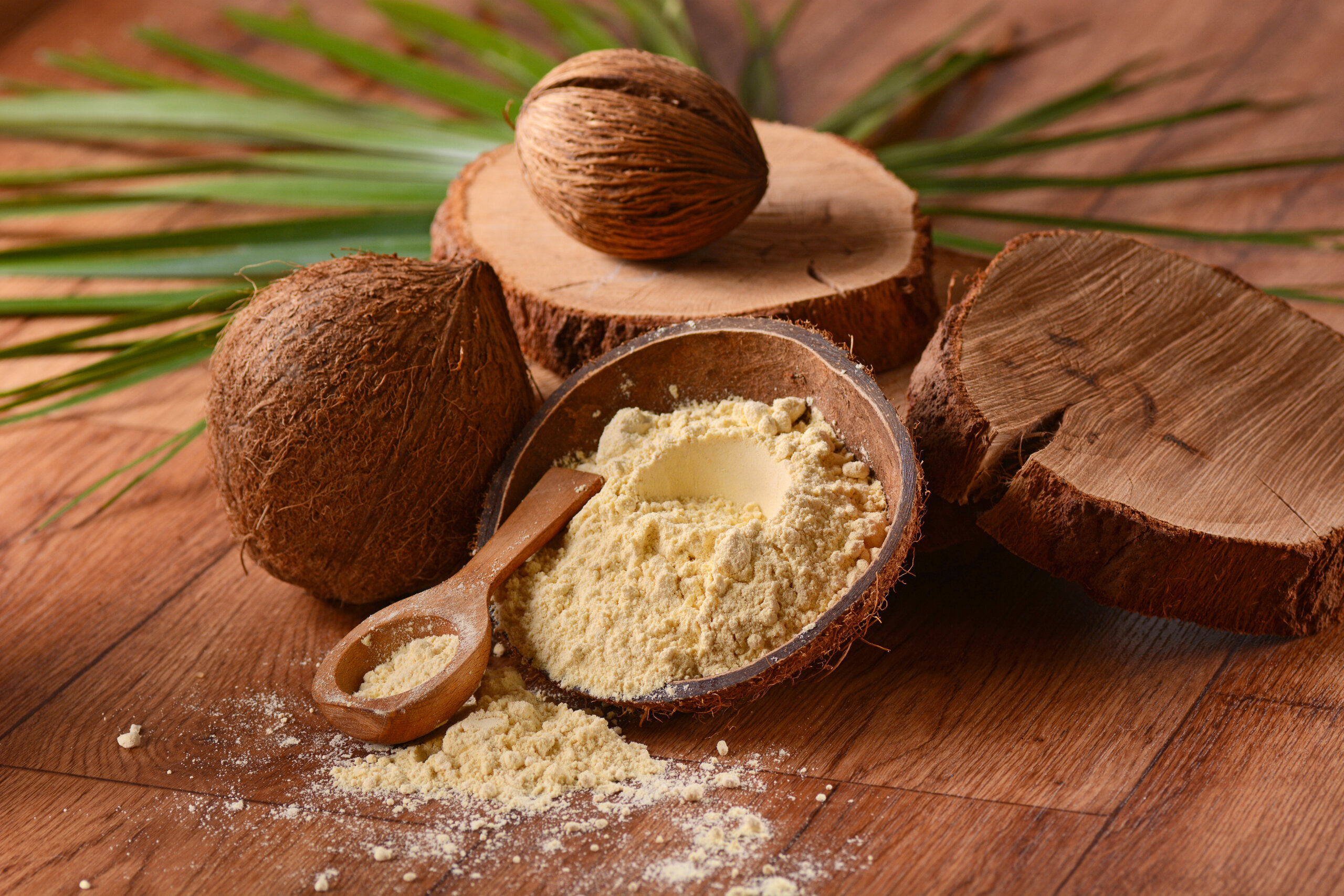Coconut has been a cash crop for decades and, even with stiff competition from other vegetable oils, it promises to continue to be a profitable venture in the future. In the United States and Europe, coconut-based products are booming in popularity. Coconut powder, coconut oil, coconut cream, coconut water, and activated coconut-shell charcoal have all become popular cooking, health, and cosmetic choices, appearing on more and more shelves and ingredient labels across the country.
Coconut really got on the radar 10 to 15 years ago, you can go to any trendy health food store or restaurant in London, San Francisco or New York, and you’ll find organic raw coconut water and vegan ice cream made with coconut products. The coconut is seen as a healthy, environmentally friendly alternative to palm oil, a common ingredient in everything from shampoos to cookies and frozen desserts.
In theory, these should be boom times for coconut farmers in the world’s major coconut-growing countries, the Philippines and Indonesia. Nonetheless, the top coconut suppliers are struggling to meet the increasing demands of the global economy. The top global coconut producers are now taking steps to ensure that their farms are sustainable enough to stand the tests of time and meet future demands.
The problem of insufficient supply to meet the increased demand is not helped by the fact that many of the trees producing coconuts today are over 50 years old, 20 years past their prime production years. According to APCC (the Asian and Pacific Coconut Community), many plantations across Asia are experiencing zero growth, and some are even ceasing production as their farmers switch their focus to oil palm production. This is creating an aging crisis. Coconuts reach peak productivity at 15 to 20 years of age, becoming gradually less productive after 30 years.
Fair Trade practices in the industry try to ensure that the benefits of the booming sector will trickle all of the way down to small farmers, but they unfortunately keep the production rates rising at a slower rate. Lack of investment in sustaining the coconut-growing land’s productivity, largely due to the high costs associated, mean that some farms are producing 75% less fruit than they did 30 years ago.
PERU
Peruvian cocoa has won international awards in recent years, being recognized as one of the best in the world. Domestication of this crop began about 4,000 years ago and the species was distributed throughout the Amazon and Mesoamerica, on the Pacific coast. Peru is classified as the third largest cocoa producer and exporter in Latin America, and has the largest genetic biodiversity in cocoa in the world.
The Cacao Amazonas Peru with Denomination of Origin stands out for its intense flavor resulting from the hours of sunshine that accumulate during the year cocoa plantations, its alkaline soils, with an optimal salinization level for cultivation and the type of clay-free texture, watered with alkaline pH waters,of good electrical conductivity. Only ripe cobs are harvested and the grains result from maintaining a mixture of grains from mainly yellow and red native cocoa with a small percentage of porcelain cocoa. This combination typical of the production area allows during grain processing to be fermented and dry a grain with particular flavor characteristics.
Another important aspect of this Amazon Cocoa Bean Peru, is that it is fermented and processed in wooden drawers and dried in the sun, managing to obtain a grain that maintains an intense flavor of chocolate and that is further enhanced when toasted later for the production of chocolate and other by-products of cocoa.
Peru Varieties
- Criollo: it is the oldest and comes from the north
- Outsider: it is the most abundant and accounts for 90% of the world’s production
- Trinitarian: original of the island of Trinidad, is a natural biological hybrid, crossing the Creole and the outsider
BRAZIL
Brazilian cocoa is considered a noble and traditional product of the country’s agriculture in the cocoa market, producing over 2,300,000 tonnes this season. However, in the early 1990s, the Brazilian market suffered a severe crisis: added to the pressures of the international market in high production, the pest called Witch’s Broom resulted in an overwhelming loss of raw material.
Despite the problems caused by witch’s broom, the Brazilian recovery in the market was effective, with the cocoa farms of Brazil ended 2010 with two positive results both in production and in quality.
INDONESIA
Indonesia is the world leader of coconut production, with over 18,000,000 tonnes harvested this season. The majority of the country’s coconuts are produced in the province of North Sulawesi.
In the last 50 years, the sector’s share in national gross domestic product has decreased considerably, due to the rise of industrialisation and service sector. Nevertheless, for the majority of Indonesian households, farming and plantation remains as a vital income generator.
Producers are pushing innovations and technologies to modernize and further develop the coconut industry. Modernizing will create more downstream industries are what will unleash the potential of this “tree of life”. Being the largest employer of Agri workers and farmers at 3.5 million, it deserves this boost in order to create local employment and reduce rural poverty.
Moreover, more downstream industries will allow farms to obtain other buyers and improve buying prices, encouraging semi processing of coconut near the farm to create more local employment for coconut farming families. However, government supports is limited, while development agencies focused on large-scale projects like dams and agribusiness plantations.
PHILLIPINES
Coconut trees dot an estimated 3.6 hectares of land in the Philippines, producing over 14,000,000 tonnes. 3.5 million Filipinos are engaged in coconut farming, with the transformation of Philippine landscapes to coconut beginning hundreds of years ago. At the moment, it is not expanding, rather, coconut areas are receding and being transformed into other land uses or mixed uses.
According to the Philippine Coconut Authority, aging is already decreasing productivity, but little replanting is taking place. Some estimate that as many as 90 percent of all coconut trees in Asia are nearing the end of their productive life cycles. That could mean that coconut production has plateaued globally and could begin to fall. Aging trees are putting the entire coconut supply chain–and the products consumers are increasingly demanding–at risk.
Philippine coconut industry stakeholders, advocacy groups and academicians debunked recent international articles claiming that coconut oil production as both environmental and biodiversity threats. Also, the United Coconut Association of the Philippines (UCAP) defended the country as to a recent scandal, claiming the use of monkey labor in harvesting coconuts was never a practice in the Philippines throughout its long history of coconut farming.
Tanzania
Agriculture is the main part of Tanzania’s economy, and some of the challenges on the agriculture industry include climate change and the resulting droughts, floods, and agriculture temperature shocks and a lack of agricultural technology. These pose severe challenges to the living standards of most of people involved in the agriculture industry in Tanzania and create huge increases in unemployment, hunger, malnutrition and starvation, and diseases rates.
The problem of post-harvest losses in the agriculture sector is huge. Farmers mention that poor demand is a major cause of produce loss in the area. However, there is also poor handling crops, lack of agronomic practices, poor transportation and low quality packaging contributes to the problem.
The IITA, a non-profit that works with partners in Africa to enhance crop quality and productivity, is working to fill some of the gaps with regards to the challenges still facing the agriculture sector. The programme works from farm to fork, starting with seed sowing, through to marketing and all the way to processing the product for consumption. They have an incubation programme, where they train people to acquire skills for agribusiness, skills for entrepreneurial development, skills for management of different technical skills and then prepare them to become businesspeople in agriculture.
The increasing variety of coconut-derivatives coupled with their health benefits has positively affected the global Coconut Foods market. Rising application of major coconut-derivatives like oil and milk is anticipated to further fuel the overall market during the forecast period. Coconut is a versatile fruit with multiple health benefits. Products derived from coconut include coconut oil, coconut water, coconut milk, desiccated coconut, coir, and copra. Food and beverage, as well as cosmetic manufacturers, are investing in research and development to extract full benefits of the fruit to enhance their product offering.
Market Influencing Trends:
- The demands for coconut water as a natural energy drink is growing rapidly
- Huge demand for coconut oil in the cosmetics industry and an increase in its popularity in food applications
Growth Drivers
- The growing preference toward healthier dairy milk alternatives and naturalness is expected to increase the demand for coconut food products
- High demand due to the growing innovations in the field, leading to enhanced product quality and enriching its dietary value
Read more on our Cocoa Products here, we would love to hear from you at sales@tradelinksa.com
[su_divider top=”no” divider_color=”#726c6d” size=”7″ margin=”5″]
[su_button url=”https://www.facebook.com/tradelinksainternational/?view_public_for=105757601162821″ target=”blank” style=”flat” size=”5″ icon=”icon: facebook-f” text_shadow=”0px 0px 0px #000000″] [/su_button] [su_button url=”https://www.linkedin.com/company/tradelink-sa/?viewAsMember=true” target=”blank” style=”flat” size=”5″ icon=”icon: linkedin” text_shadow=”0px 0px 0px #000000″] [/su_button] [su_button url=”https://www.instagram.com/tradelinknz/” target=”blank” style=”flat” size=”5″ icon=”icon: instagram” text_shadow=”0px 0px 0px #000000″] [/su_button] [su_button url=”https://www.youtube.com/channel/UCewEsyFy0Y_1MdjwhsXvT0w” target=”blank” style=”flat” size=”5″ icon=”icon: youtube” text_shadow=”0px 0px 0px #000000″] [/su_button]
[su_youtube_advanced url=”https://www.youtube.com/watch?v=LCEkNZdMi04″ height=”200″ responsive=”no” fs=”no”]



